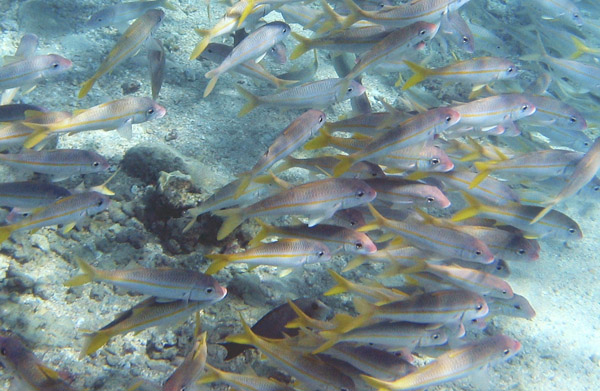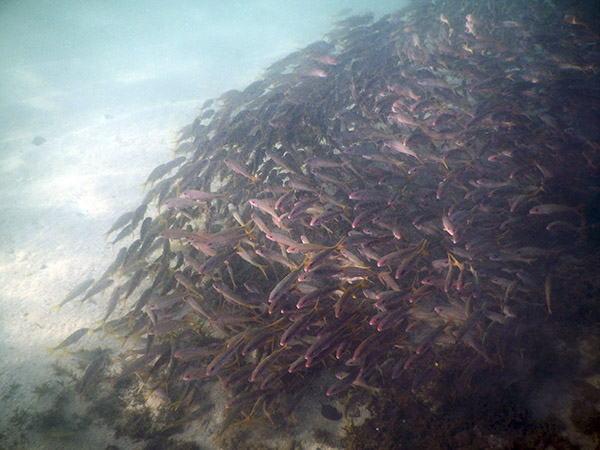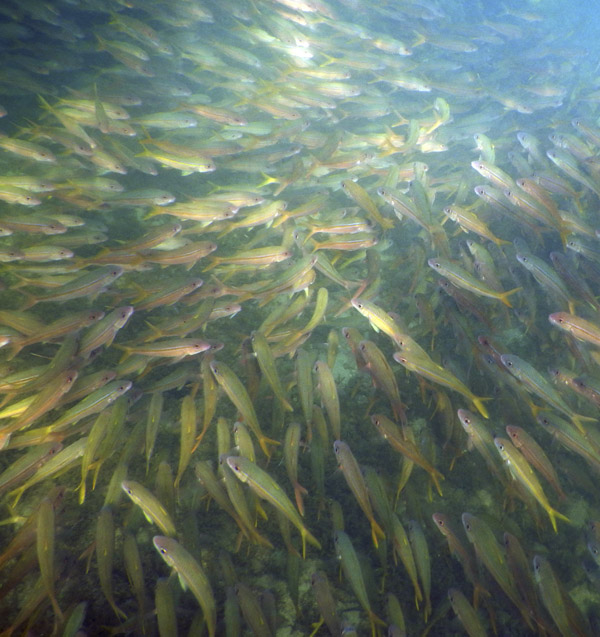Published in the Ocean Watch column, Honolulu Star-Advertiser © Susan Scott
September 14, 2015
At my favorite snorkeling spot recently, I found a line of anglers blocking my usual beach entrance. I hadn’t seen them there before but I recognized the scene. In August and September, it’s common around the islands to see men, women and children fishing near one another with short poles in knee-deep water, white buckets waiting on the beach. Years ago, I didn’t know what this configuration meant so I asked an angler who explained that they were fishing for oama.
 Weke are yellowstripe goatfish; when they are
Weke are yellowstripe goatfish; when they are
under 7 inches long, like the fish shown here, they’re oama.
Courtesy Scott R. Davis
“My wife fries them up,” he said. “Delicious.”
Besides being good eating, the man told me that some anglers use oama as bait for papio.
“What are oama?” I asked.
“Baby weke,” he said.
Papio are the young of members of the jack (ulua) family and weke are yellowstripe goatfish. When weke are under 7 inches long, they’re oama.
Ten species of goatfish of various Hawaiian names swim in Hawaii’s waters. All are bottomfish that cruise the ocean floor poking two stiff chin whiskers into the sand and sediment. When the fish finds a shrimp, crab, worm or snail, it shoves its snout in the sand to nab it.
Goatfish are experts at finding the goodies because taste buds cover the wiggly extensions, which apparently reminded someone of a goat’s beard. Jacks and wrasses sometimes take advantage of the goatfish’s hunting tools and tag along, hoping to filch a flushed prey.
Weke are familiar to us snorkelers because these 14-inch-long fish like to forage in shallow water. The buttery yellow stripe running down the cream-colored body makes yellowstripe goatfish hard to spot at first, but when hunting, the fish blow their cover. The busy whiskers, called barbels, leave puffs of sediment in their wake.
Male goatfish also flutter their barbels to court females. (Look! I can waggle my whiskers!) When not eating or dating, goatfish tuck their goatees out of sight under their chins.
Weke spawn at the edge of the reef and the resulting young hatch at sea. In late summer, the youngsters return to the reef, often hanging together by the hundreds.
Because I couldn’t politely get past the dozen or so oama fishers standing at my snorkeling spot, and didn’t want to risk getting hooked, I walked down the beach and entered there.

And whoa! There beyond the sand, tucked into the corner of two coral heads, hung a thousand resting oama, maybe more. Their yellow-striped bodies shimmered in the morning sun and they moved in that beautiful fluid synchrony of schooling fish.
I hope they made a run for it.
